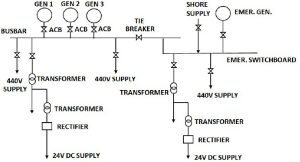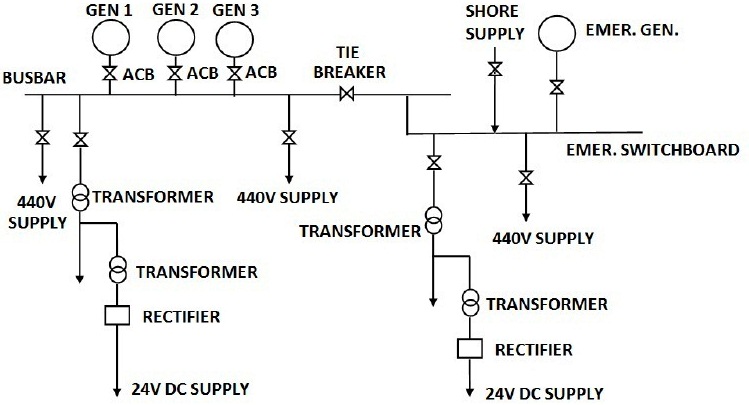The electrical system of a ship is a complex network that powers everything from navigation equipment to lighting and machinery. Understanding how this system works is essential for anyone interested in maritime studies or careers in the marine industry. In this article, we will explore the key components of a ship’s electrical system, the role of generators, the significance of load sharing and synchronization, and the various electricity consumers onboard.
What Makes Up a Ship’s Electrical System?
A ship’s electrical system consists of several key components that work together to generate, distribute, and utilize electrical power. These components include:
- Generators: The primary source of electricity on a ship.
- Main Switchboard (Busbar): A centralized system that distributes generated power to various parts of the ship. It connects the ship’s generators, shore supply, and emergency systems, ensuring efficient power management.
- Transformers: Devices that step down high-voltage power (e.g., 440V) to lower voltage levels (e.g., 220V) or convert AC to DC for specific applications like 24V DC systems.
- Rectifiers: Convert alternating current (AC) to direct current (DC), supplying power to essential systems like emergency lighting and control circuits.
- Batteries: Provide backup power for critical systems, ensuring functionality during generator failure or emergencies.
- Electrical Consumers: Devices and systems that use electricity, such as lights, pumps, and navigation equipment.
Together, these elements ensure that all onboard operations run smoothly.

Why Do Ships Need Generators?
Generators are crucial for providing electrical power on ships. Generators convert mechanical energy produced by the ship’s engines into electrical energy. This process is essential for powering various onboard systems, including navigation equipment, communication devices, lighting, and safety systems. Without generators, these critical functions would be compromised. Most ships utilize diesel generators due to their reliability and efficiency. Diesel engines are known for their durability and ability to operate effectively under varying loads and conditions. This makes them particularly suitable for marine environments where consistent performance is crucial.
Beyond just lighting and navigation, generators also power essential systems such as pumps for ballast and bilge water management, refrigeration for food storage, and HVAC systems for crew comfort. The uninterrupted operation of these systems is crucial for the safety and well-being of both crew and passengers.

Main Switchboard (Busbar)
The main switchboard is a crucial part of a ship’s electrical distribution system. It acts as the control center, distributing electricity from generators to various parts of the ship. The switchboard also integrates additional power sources, such as the shore supply and the emergency generator, which ensures continuity in case of main power failure. Switchboards are equipped with circuit breakers (e.g., Air Circuit Breakers or ACBs) to protect the electrical system and enable safe load management. The tie breaker links different sections of the busbar, allowing flexibility in power distribution and facilitating maintenance without disrupting operations.
Transformers and Electricity Consumers: Understanding Their Role
Transformers are critical components of a ship’s electrical system, adjusting voltage levels to suit the needs of various onboard systems. Different electrical consumers rely on specific voltage supplies, categorized as follows:
440V Supply and Consumers
- Role of Transformers: The 440V supply is the primary high-voltage output from generators, powering heavy-duty equipment essential for ship operations.
- Consumers:
- High-power pumps (e.g., ballast and bilge pumps).
- Cargo machinery such as cranes and winches.
- Large motors and air compressors.
220V Supply and Consumers
- Role of Transformers: Transformers step down the 440V supply to 220V for medium-power applications and general electrical systems.
- Consumers:
- Lighting in accommodation areas and passageways.
- Kitchen appliances and HVAC systems for crew comfort.
- Navigation equipment such as radars and GPS.
24V DC Supply and Consumers
- Role of Transformers and Rectifiers: Transformers and rectifiers convert the 440V or 220V AC supply into 24V DC, a stable and reliable voltage for critical systems.
- Consumers:
- Emergency lighting for safety during power failures.
- Control systems for operating machinery.
- Alarm systems and safety equipment.
By adjusting and converting voltage levels, transformers ensure efficient power distribution throughout the ship, meeting the diverse needs of all onboard consumers. Understanding these systems is essential for managing power demand and ensuring smooth and reliable operations at sea.
When More Power is Needed?
In situations where the electrical load exceeds the capacity of a single generator—such as during heavy operations or when multiple systems are running simultaneously—ships often use multiple generators. This practice ensures that there is enough power available to meet demand without overloading any single generator.For example, if a ship’s lighting, navigation systems, and cargo pumps are all in use at the same time, two or more generators may be required to provide sufficient electricity. This approach not only prevents generator failure but also enhances the overall reliability of the ship’s electrical system.
–
Synchronization and Load Sharing
– What is Synchronization?
Synchronization refers to the process of aligning multiple generators so they can operate together effectively. When two or more generators are synchronized, they produce electricity at the same voltage, frequency, and phase. This alignment is crucial because it allows for smooth operation without causing fluctuations in power supply.For instance, when a second generator is brought online to share the load with an existing generator, it must be synchronized first. If synchronization is not achieved correctly, it can lead to equipment damage or power outages.
– What is Load Sharing?
Load sharing is closely related to synchronization. It involves distributing the electrical load evenly among all operating generators. This practice ensures that no single generator is overloaded while others remain underutilized.For example, if three generators are running but one is carrying most of the load while the others are barely working, it could lead to wear and tear on that generator. By sharing the load evenly, all generators can operate efficiently and have a longer lifespan.
Understanding a ship’s electrical system is vital for anyone interested in maritime careers. From generators that produce electricity to various consumers that utilize it, each component plays an important role in ensuring safe and efficient operations at sea.By learning about synchronization and load sharing, students can appreciate how complex systems work together to provide reliable power on ships. As technology continues to evolve in the maritime industry, knowledge of these fundamental concepts will be invaluable for future maritime professionals.Whether you aspire to be an engineer on a vessel or simply want to understand how ships operate, grasping these concepts will give you a solid foundation in maritime studies.


Hi i am kavin, its my first occasion to commenting anywhere, when i read this paragraph i thought i could also
make comment due to this good paragraph.
My first impression is positive, it feels trustworthy right away.
First impression is strong, I trust this site immediately after visiting.
The name itself feels catchy, easy to remember and fun.
Overall, the site feels exciting, enjoyable, and refreshing.
Everything seems thoughtfully put together, very pleasant to scroll through.
I’m impressed by the flow, pages feel connected and inviting.
The site feels professional, with a clear focus on healthcare.
I’d revisit this brand, its presentation leaves a firm impression.
Navigation is decent, I didn’t get lost while clicking around.
Overall feels promising, I’ll revisit soon to see what’s new.